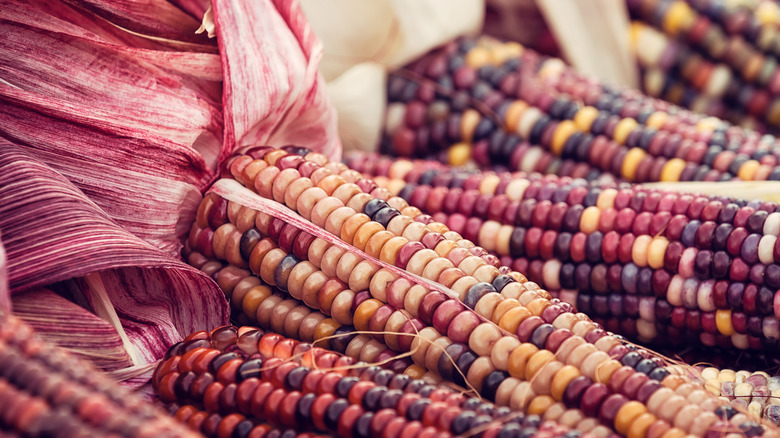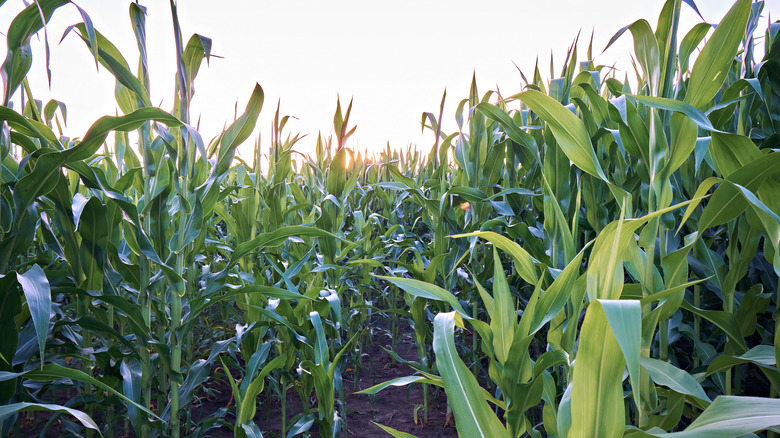What Is Flint Corn And What Is It Used For?
Whenever autumn rolls around with Thanksgiving on its horizon, you see a particular decoration popping up nearly everywhere you look. Vibrant, multicolored corn, arranged in baskets, bundles, banners, and even linked wreaths, seems to be the go-to aesthetic for the season. But there's one place you never seem to see this type of corn — on your plate. Have you ever wondered why these colorful cobs are so vastly different from the corn we're used to eating?
This decorative variety of corn is known as flint corn, a label that alludes to its rock-hard kernels. It also goes by the name Indian corn, an improper reference to Native Americans that thankfully appears to be going out of style. Indigenous people do, however, deserve credit for flint corn, and all corn for that matter. Corn has a fascinating ancient history going back thousands of years, with flint corn specifically cultivated by tribes like the Pawnee in what is now the northern United States.
Most people probably associate flint corn with its decorative purpose alone. However, it actually plays a significant role in our diets. Flint corn is mainly used to make cornmeal, from which all kinds of delicious dishes emerge. It is also used to make hominy, grits, polenta, atole, and masa. Off the cob, flint corn has an unpleasant texture, so we only cook with it in these ground-up forms. Thus, it flies under the radar, and one of the most common ingredients in our pantries is hardly ever spoken of.
What is flint corn?
Flint corn bears the scientific name Zea mays L., identifying it as a member of the Zea mays family to which all varieties of corn belong. However, you won't hear it called corn outside of the U.S., as other countries use the term maize.
Flint corn's most standout trait is undoubtedly its color. Different varieties of flint corn exhibit different hues, but they all tend to be pretty dark, with a color palette of red, orange, yellow, gold, and blue. The most famous varieties for decorative purposes have multi-colored kernels, which are the result of breeding efforts made over the last 50 years. Farmers have cross-pollinated monochromatic flint corn to produce varieties bearing both colors. These multi-colored versions are sometimes called calico corn.
In keeping with its name, flint corn has extremely hard kernels, with its outermost layer being made of hard starch. However, the inside of flint corn kernels is actually packed with soft starch, which plays a significant role in its culinary uses. These kernels are quite smooth and sometimes even shiny. Some people seek to enhance this trait for decorative purposes by coating cobs of flint corn in lacquer.
What makes flint corn different from other types of corn?
Most of the corn cultivated on farms can be grouped into five categories: flint corn, sweet corn, dent corn, flour corn, and popcorn. The juicy corn we eat off the cob is sweet corn, which has soft kernels and a high sugar content. It's the corn you're probably most familiar with, but it's not the most widely grown. That would be dent corn, which looks like sweet corn save for a slight indentation in each kernel. It's used for livestock feed, corn syrup, and alcohol, specifically bourbon.
Flint corn doesn't have much in common with the sweet and dent varieties, having a hard exterior, low sugar content, and different industrial uses. It is much more similar to flour corn. Both come in an array of colors and are mainly used for cornmeal. However, flour corn is sweeter and softer than flint corn, and it yields a finer grind of cornmeal. Some varieties of corn mix flint and flour traits.
Popcorn may be the most interesting of the bunch. It's actually a type of flint corn, but it is classified separately because not every type of corn will pop. This happens because popcorn kernels have a particular level of moisture trapped under the hard outer layer. When popcorn is exposed to heat, that moisture turns into steam, which creates so much pressure that the kernel explodes and turns inside out. This won't happen with any other type of flint corn.
Popular varieties of flint corn
Flint corn has numerous cultivars or varieties produced by selective breeding, many of which were developed by indigenous farmers multiple millennia ago. They mainly serve the same purposes but have different histories, appearances, and endemic lands. Here are a few of the most popular.
It's only fitting to start with Chapalote, also known as pinole maiz. This is one of the most ancient known cultivars of corn, grown by Mesoamericans since at least 1,000 B.C. It is endemic to Northern Mexico and is now grown in the Southwest U.S. as well. It is monochromatic, with kernels ranging from tan to dark brown. It is actually one of the popcorn varieties of flint corn and is also ground for pinole, a mixture of corn and cacao used in porridge.
Though flint corn is native to the Americas, it has become an essential ingredient around the world, as exemplified by floriani red corn. This cultivar originated in the Italian Alps, becoming a staple food of the region. Its kernels have a ruby-red exterior and yellow interior, making for a vibrantly yellow cornmeal with a hint of pink.
As far as more contemporary cultivars of flint corn go, the glass gem variety has to be the most famous. Its multicolored kernels look like polished jewels, brighter than other types of flint corn. Pictures of glass gem corn have occasionally gone viral on the internet, and their appearance is so stunning that many people think it's photoshopped.
Where can you get flint corn?
Finding flint corn for culinary purposes is problematic. Just think — have you ever seen corn in a grocery store that wasn't yellow or white? When flint corn appears at major markets, it's sold as decor. You'd probably find more flint corn at craft and home goods stores rather than groceries. You could potentially use this flint corn for cooking, but you need to be wary of the fact that some cobs have a lacquer coat.
When we struggle to find things in stores, where do we go? The internet, of course. Searching flint corn for sale will turn up lots of results, but here's the thing: You'll find most companies selling seeds instead of the finished product. The truth is, growing flint corn may actually be the best way to get a quality, food-grade variety. It's challenging, though, as corn requires a lot of space. The plants should be about a foot apart from each other. They are anything but small, with some varieties of flint corn growing as tall as 12 feet.
Flint corn is an annual, harvested in late summer or early fall, which explains why we always see them around Thanksgiving. The key is to plant it just after the last spring frost and harvest just before the first fall frost. You can tell it's ready for harvest when the husk turns brown. Different kinds of flint corn require different environmental conditions, so look up which kinds thrive in your area before planting.
What can you make with flint corn?
Most people cook with flint corn without even realizing it. When you buy cornmeal, masa, grits, or polenta, there's a strong chance it was made from flint corn. But what if you want to start from scratch with a flint corn on the cob? Honestly, your best bet would still be to grind it into one of the aforementioned products. All you need for this is a coffee grinder or high-speed blender.
For certain applications, such as masa, you need to nixtamalize the corn kernels. This entails soaking them in a mix of water and food-grade lime. It removes the kernels' hard outer layer, making them easier to work with.
It is possible to eat whole kernels of flint corn, best done by soaking and boiling them for many hours as part of a soup or stew. Although flint corn isn't sweet, it has a robust, earthy flavor that's richer than the sweet corn you're used to. However, the kernels' high starch content inevitably makes them gummy.
There's another way to cook with flint corn kernels that will be more familiar, and that's making popcorn. While you can only make actual popcorn from popcorn varieties of flint corn, other varieties can be used to make something similar. When the dry kernels are heated, they will crack open and expose some of the starch inside. The result is a little like corn nuts, but it gives you the rich flint corn flavor in its purest form.





